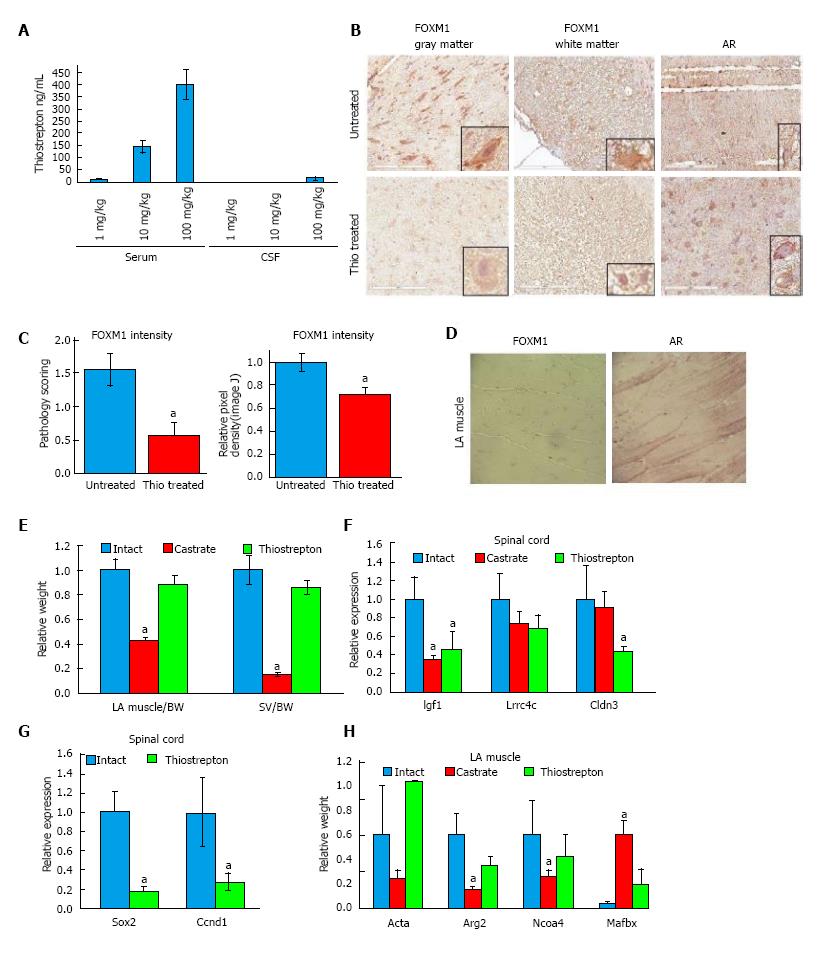Copyright
©The Author(s) 2017.
World J Biol Chem. May 26, 2017; 8(2): 138-150
Published online May 26, 2017. doi: 10.4331/wjbc.v8.i2.138
Published online May 26, 2017. doi: 10.4331/wjbc.v8.i2.138
Figure 5 Thiostrepton treatment inhibits androgen receptor activity in rat spinal cord but not muscle.
A: Rats (n = 3) were administered 1, 10, or 100 mg/kg intraperitoneal injections thrice per week for four weeks. One hour following the final dose, blood and spinal fluid were collected and analyzed by mass spectrometry. Thiostrepton displayed the expected dose response in the serum, but much less was found in the cerebral spinal fluid; B-F: Rats (n = 7) were treated with 100 mg/kg per day thiostrepton or vehicle for four weeks using intraperitoneally implanted osmotic pumps. Intact and castrate cohorts were included as controls; B, C: Immunohistochemistry revealed a reduction in the expression of FOXM1 in spinal cords compared to untreated (intact or castrate) animals. AR staining was also strong in the neurons; C: FOXM1 staining intensity was quantified by a veterinary pathologist (left) or by ImageJ (right) and found to be significantly reduced by thiostrepton treatment; D: IHC revealed weak to no FOXM1 staining in LA muscle tissue while AR staining was prevalent; E: Tissues were harvested and weighed. Castration significantly reduced the weight of the LA muscle (P < 0.01) and seminal vesicles (SV) (P < 0.01) compared to intact animals while thiostrepton treatment did not. (F-H) RT-qPCR was used to quantify the levels of androgen-regulated transcripts in spinal cord (F) or LA muscle tissue (H) or FOXM1-regulated transcripts in spinal cord (G). Thiostrepton was able to decrease the levels of androgen-regulated transcripts in spinal cords to a similar or greater extent than castration, suggesting inhibition of AR activity, while in LA muscle, castration had a much stronger effect on AR activity than thiostrepton treatment. Two FOXM1 target gene transcripts were decreased with thiostrepton treatment, demonstrating an on target effect of the drug. Error bars represent the mean ± SEM, aP < 0.05 (P < 0.08 in G). AR: Androgen receptor.
- Citation: Otto-Duessel M, Tew BY, Vonderfecht S, Moore R, Jones JO. Identification of neuron selective androgen receptor inhibitors. World J Biol Chem 2017; 8(2): 138-150
- URL: https://www.wjgnet.com/1949-8454/full/v8/i2/138.htm
- DOI: https://dx.doi.org/10.4331/wjbc.v8.i2.138









